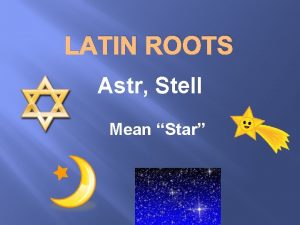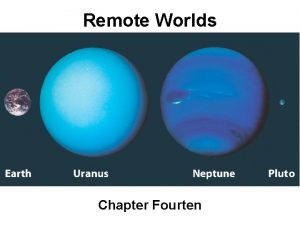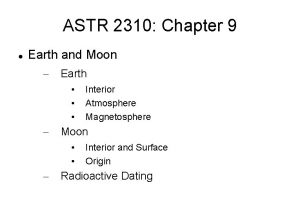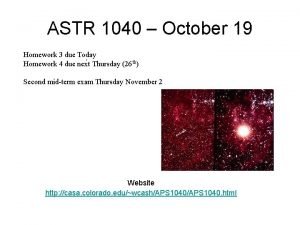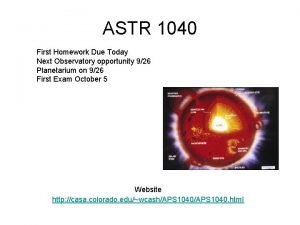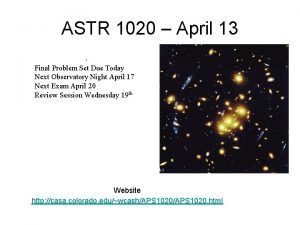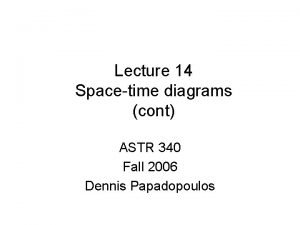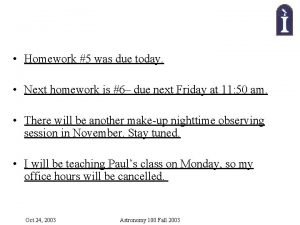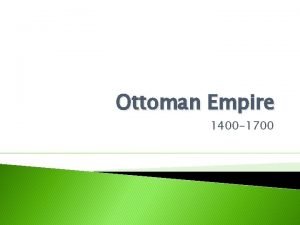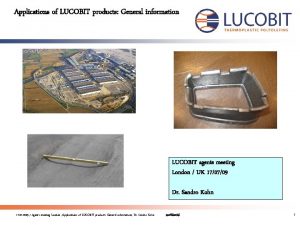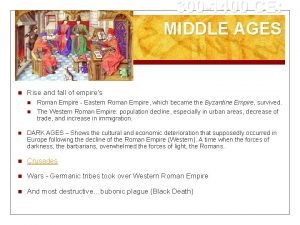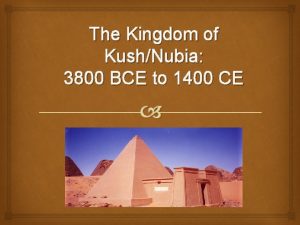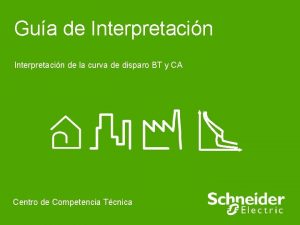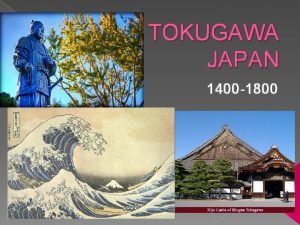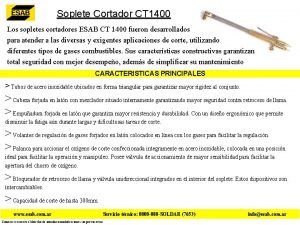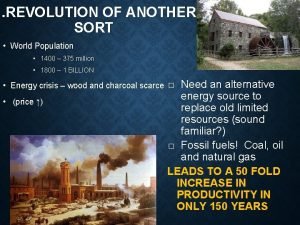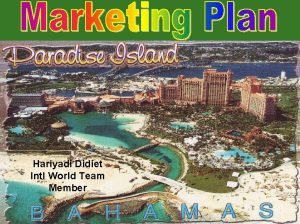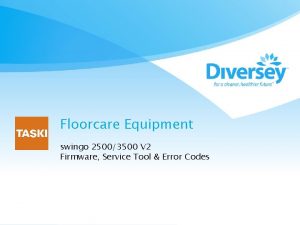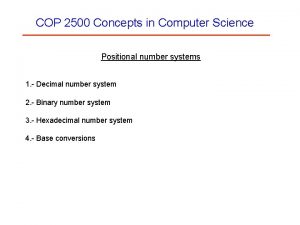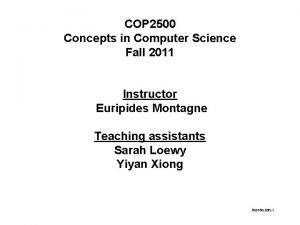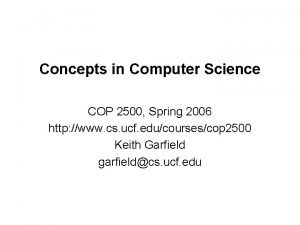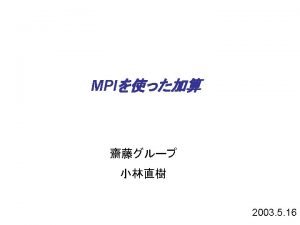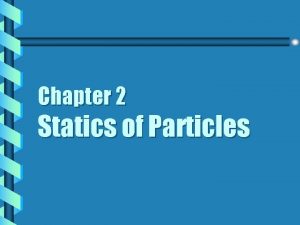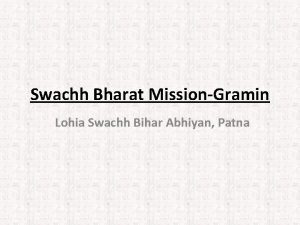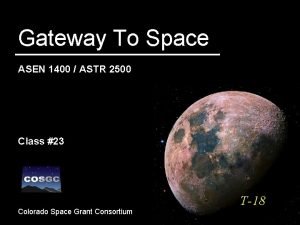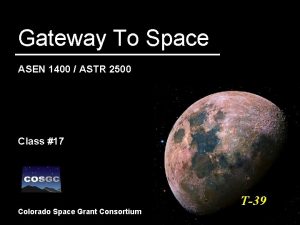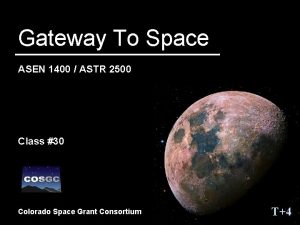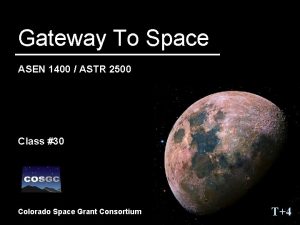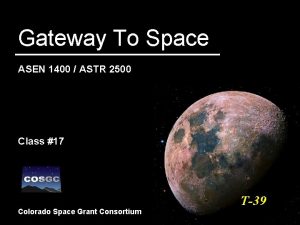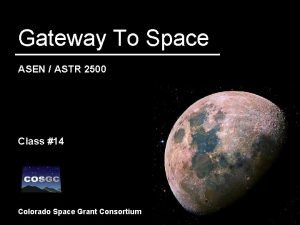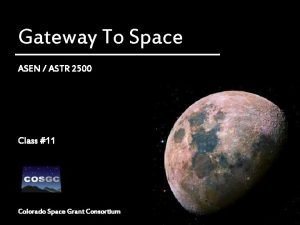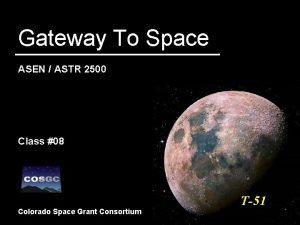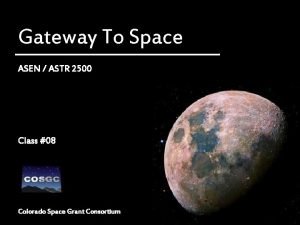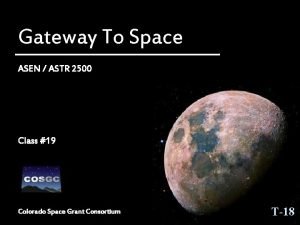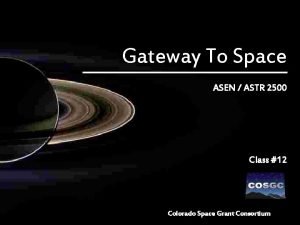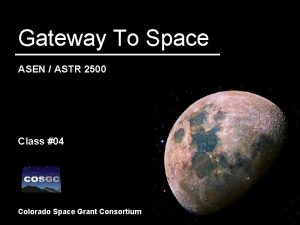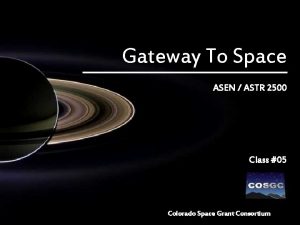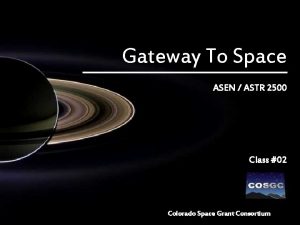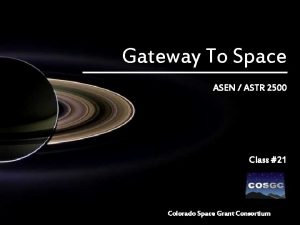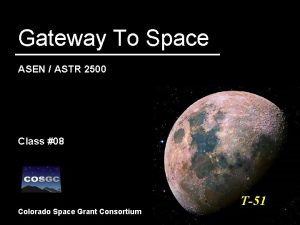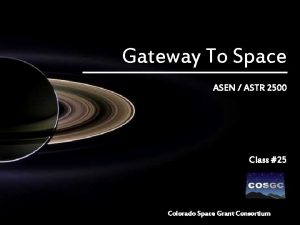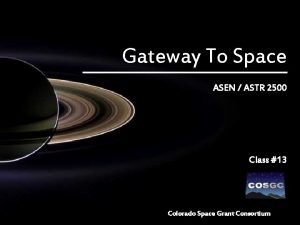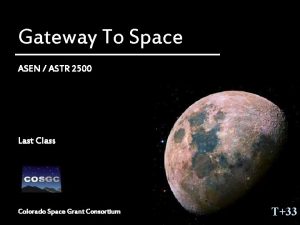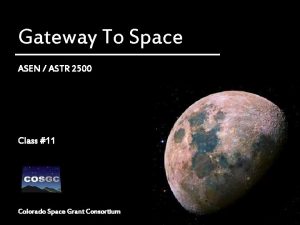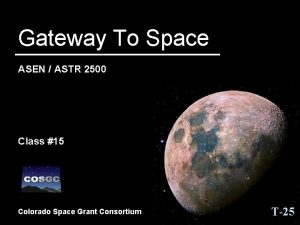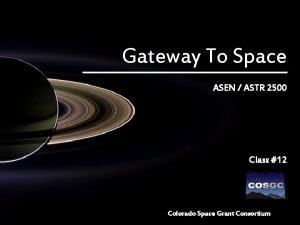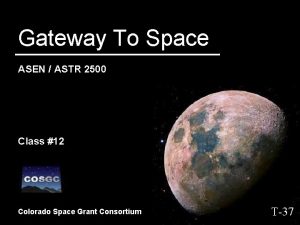Gateway To Space ASEN 1400 ASTR 2500 Class








































- Slides: 40

Gateway To Space ASEN 1400 / ASTR 2500 Class #17 Colorado Space Grant Consortium T-39

Today: - Announcements - One Minute Report Questions - Guest Lecture on Systems Engineering

Announcements: - Hardware for teams… - Pressure sensors and other hardware UNO $$$ - Latest grades posted later today - Feedback on DD Rev A/B next Tuesday - DD Rev C assigned today and due 11 -16 -12 - Don’t forget about HW #8 – Review it first

Announcements: - Traveling tomorrow – Planned - Guest speaker is not coming – Not Planned - So tomorrow is…

Next Time… Spider Plus remote introduction (Originally the lecture scheduled for November 15 th) Colorado Space Grant Consortium

One Minute Report Questions: - What kind of rocket is Dreamchaser? - What is Dreamchaser used for? - Where do dropped engines go? Orbit, outerspace? - Biggest advance from past to present rockets? - Do all space programs work together now? - How do private companies get funded?

One Minute Report Questions: - Why do they chose solid vs. liquid, vs. hybrid? - As an aerospace major, how well versed should I be with coding/programming? - What happened to the Orion space missions? - What does the future of space exploration look like?

Questions? Colorado Space Grant Consortium 8

Homework #7 Review Colorado Space Grant Consortium 9

Homework #7: NASA Mission Announcement – Chu. Sat Design a spacecraft in 30 minutes that will meet the following two requirements: 1. The total mass of the power, science instruments, and propulsion shall not exceed 900 lbm. a. The propulsion mass shall include the mass of propellant 10

Homework #7: NASA Mission Announcement – Chu. Sat Design a spacecraft in 30 minutes that will meet the following two requirements: 2. The spacecraft shall collect a minimum of 20 hours of scientific data a. The spacecraft shall collect data in the 1 x 10 -9 to 1 x 10 -10 wavelengths b. The spacecraft shall collect data in the 1 x 10 -3 to 1 x 10 -4 wavelengths The following subsystem capabilities and specifications are at your disposal. 11

Homework #7: 12

Homework #7: 13

Homework #7: 14

Homework #7 - (Answer) Science - Infrared Sensor - X-ray Sensor Total Science Mass 75 W 100 W 30 lbm 40 lbm 70 lbm If only one sensor is on at a time is the requirement of 20 hours met? Only have one sensor on at a time, therefore the Science power requirement is 100 W, not 175 W. 15

Homework #7 - (Answer) Power Need at least 1, 000 W to stay alive plus 100 W for science therefore you need to have at least 1, 200 W solar array and battery Total weight = 60 lbm for solar array = 120 lbm for battery Total = 180 lbm You will find out the Fuel cell is way too heavy 16

In-Class Exercise: (Answer) Propulsion Need at least 80 lb of thrust therefore you need the following Two 25 lb thrusters Three 10 lb thrusters = 20 W 25 lbm 15 lbm Total Power Total Mass = (40+60 W) = 100 W = (25+25+15+15+15) =95 lbm 17

In-Class Exercise: (Answer) Total Mass Science Power Propulsion Total = 70 lbm = 180 lbm = 95 lbm = 345 lbm (minus propellant) 18

In-Class Exercise: (Answer) Propellant Mass 2 x 25 lb = 50 per/100 lbm 3 x 10 lb = 20 per/100 lbm Total = 100 lb = 60 lb = 160 lb per 100 lbm 345 lbm / 100 lbm * 160 lbm = 552 lbm 19

In-Class Exercise: (Answer) Total Mass Science Power Propulsion Total = 70 lbm = 180 lbm = 95 lbm = 345 lbm (minus propellant) Propellant = 552 lbm Total mass = 897 lbm 20

Systems Engineering Jessica Brown Lockheed Martin Rachel Landess Lockheed Martin Colorado Space Grant Consortium

Introduction to Systems Engineering October 23, 2012 Rachel Landess Keith Morris Jessica Brown 22

What is Systems Engineering • Is a systematic, interdisciplinary approach that transforms customer needs into a total system solution • A framework of interrelated activities that spans Design, Management, and Realization of systems • Balances customer needs with system capabilities • Led and organized by Systems Engineers – But all functions play a role • It is the technical “glue” which makes separate design disciplines and subsystems function together to provide an integrated system 23

Be a “Systems Thinker” • The Design Engineer – The specialist's viewpoint – Views the system from the inside – Concerned with other system elements only as they affect their own design task – Not necessarily how their system may affect others • Systems thinkers – Views the system from the outside. – Concerned with the effect of all system elements as they affect overall system design / performance / cost / schedule – Concerned no matter where the hole in the boat is 24

Systems Engineering must focus on the entire problem: optimize the whole, not the parts! 25

The Art & Science of Systems Engineering • Art of Systems Engineering – Technical Leadership – Understanding how all the individual pieces go together to make the big picture • Science of Systems Engineering – Systems Management – Managing all the details for every piece of the system and keeping them in synch • Cost, Schedule, Performance, & Risk To be Successful, we must balance both technical leadership and systems management into complete systems engineering 26

Systems Engineering “V” Model 27

Architecture • System Architecture is the overall structure of the program, internal interfaces, and how it interacts with external interfaces – System Level – Constellation of Satellites, Ground stations, etc. – Spacecraft Level – Subsystems and interfaces that make up spacecraft – Subsystem – Components and technologies that make up subsystem – Architect’s role is to ensure customer requirements and needs are properly addressed in the system • Identifies utility and flexibility of the system • Optimizing architecture can make spacecraft trades easier 28

Spacecraft Architecture (image credit: NASA/GSFC) 29

Concept of Operations • Concept of Operations (CONOPS) – How the system will be used – Links technical requirements with user’s needs • Requirements do not fully represent customer’s wishes… – Operational scenarios, timelines, block diagrams, orbital maneuvering among the products – Example: Assignment Requirements do not specify how often payloads need to operate, could reduce overall power required 30

Con Ops Example – ALL-STAR 31

Requirements Management • A requirement is a “single, verifiable shall statement” • Requirements dictate the form, fit and function the system design shall meet • Requirements address both characteristics as well as capabilities – Characteristics=what the system shall be – Capabilities=what the system shall do • Higher level requirements are decomposed to lower level requirements 32

Why are requirements important How the customer explained it How materials ordered it How the project manager understood it How it was built How the engineers designed it How the customer really wanted it Clearly communicating requirements is essential 33

Design Integration • Balance the needs of the customer with the capabilities of the spacecraft • Balance the needs of the individual subsystems – Allocate mass, volume, power constraints – Relate it to their assignment • Ensuring subsystems are talking with one another – Making sure they are compatible • Identifying subsystem interfaces Its kind of like Herding Cats 34

Risk Management Risk Matrix Probability of Occurrence • Risk management is done throughout the entire program life cycle • Risk is defined in two dimensions – Probability of occurrence – Consequence if the risk occurs • Identify risks while there is still time to react • Put in place mitigation strategy to minimize or eliminate risks • Sources of risks include: – Poorly defined technical tasks or cost estimations – Poorly defined requirements and interfaces – Low technological maturity (technical risks) – Unrealistic project planning or inadequate resources – Inadequate workforce skill level 5 4 3 2 1 1 2 3 4 5 Consequence 35

Hardware Integration • Assembly of spacecraft hardware Spitzer Space Telescope from design to integration 36

Verification and Validation • Verification – “Did we build the system right” • Validation – “Did we build the right system” • System Testing – Functional tests – Vibe tests (drop tests) – Shock tests (swing tests) – Thermal Vacuum tests – Acoustic tests ALL-STAR and team at vibe test at Lockheed Martin 37

Mission Operations • Starts when spacecraft development is initiated and continues through final disposal of space asset • Provide mission requirements support for development of operational systems – Used to plan and control launch vehicle and spacecraft operations • Developing mission profiles, operational procedures and related operational documentation • Balance and allocate operational requirements with operational performance • Determine operations integration tasks – Defining capabilities and constraints associated with launch vehicles, spacecraft and mission control and ground systems 38

Summary • Systems Engineering is an integrated composite of people, products, and processes – Forms a structured development process – Spans design, production, and operation of systems • Balances the needs of the customer with the capabilities of the system • Uses technical leadership and systems management – Integrates all disciplines and specialty groups into team – Manages cost, schedule, performance, and risk • There is no perfect solution – Systems engineering produces the optimal solution for the entire spacecraft 39

 Robert asen
Robert asen Astr greek or latin
Astr greek or latin Astr
Astr 5 a day language review week 3
5 a day language review week 3 Astr
Astr Astr
Astr Homework due today
Homework due today Astr
Astr Inertial observers
Inertial observers James webb nasa space telescope launch
James webb nasa space telescope launch Bracione
Bracione Ottoman empire 1400
Ottoman empire 1400 Map of asia 1400
Map of asia 1400 Lucofin 1400 mn
Lucofin 1400 mn 4x = 3 (mod 9)
4x = 3 (mod 9) 1100-1200 lexile books
1100-1200 lexile books Scoperte geografiche 1400
Scoperte geografiche 1400 Ptmeg 1400
Ptmeg 1400 1400*74
1400*74 Landmarks in humanities
Landmarks in humanities 300/1400
300/1400 Pbb dari 220 dan 1400
Pbb dari 220 dan 1400 3800+1400
3800+1400 Micrologic 1400
Micrologic 1400 Toreador fresco at knossos, c.1450-1400 bc
Toreador fresco at knossos, c.1450-1400 bc Japan 1400
Japan 1400 Ct-1400
Ct-1400 1400/375
1400/375 Early and high renaissance (1400–1550)
Early and high renaissance (1400–1550) The inca lived in which mountain range: *
The inca lived in which mountain range: * Alfred buys an old scooter for rs 4700
Alfred buys an old scooter for rs 4700 Royalti herbalife
Royalti herbalife Taski service tool download
Taski service tool download Plan de 90 dias herbalife
Plan de 90 dias herbalife Computer science
Computer science Cop 2500
Cop 2500 Cop 2500
Cop 2500 2500*5001
2500*5001 The tension in the guy wire is 2500 n
The tension in the guy wire is 2500 n 350000/2500
350000/2500 Mass density volume questions
Mass density volume questions

